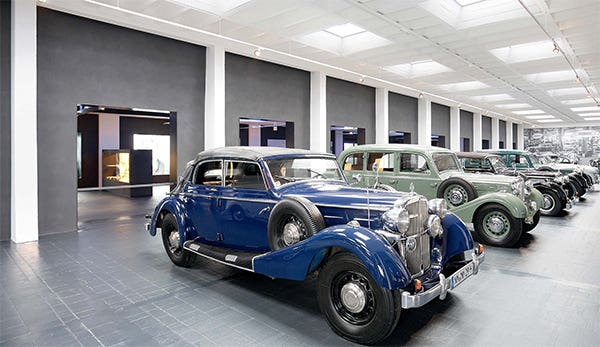The 1969 Dodge Daytona was unmistakable from any angle.
According to Bill Stech, the owner of this car, driving the Daytona
“is like going down the road with a naked woman on the hood.
Everybody does a double take and turns and stares!”
It was the 1960s, and performance was the name of the game. For Dodge racing boss Bob McCurry, there was only one acceptable result: Win. Chrysler Corp. and Ford Motor Co. spent hundreds of thousands of dollars to dominate stock car racing in NASCAR, ARCA and USAC’s stock car division with aerodynamic vehicles, and Chrysler did not take losing easily. With the horsepower equation already answered by the 426 Hemi, designers with a background in aerodynamics turned to figuring out ways to get a car through fast air more efficiently. Compared to the original Charger’s configuration in 1966-’67, the restyled 1968 model was less stable at high speed.
Subsequently, a series of wind-tunnel tests were done at Wichita State University and at Lockheed in Georgia, which allowed a first-hand look at how superspeedway air actually moved over a vehicle.
Unlike the Chrysler Airflow models of the 1930s, which were based on theory, these tests created hard evidence of what worked. The result was some needed changes to the body design, and a new name to match the changes: Charger 500. The Charger 500 would make its formal super speedway debut at Daytona in 1969, but the also-new and slicker Ford Torino Talladega and Cyclone Spoiler II gave up little ground, and they didn’t let the Dodges get by them. Lee Roy Yarbrough’s Mercury beat the Charger 500 of Charlie Glotzbach to win the event. Undaunted, McCurry gave the go-ahead to the ultimate weapon, the Dodge Charger Daytona, which had been tentatively planned for 1970, but moved forward for a race debut in September of 1969, where it, ironically, won at a new track in Alabama nicknamed Talladega.
But what of the street-bred machinery that was required to homologate, or legalize, these unorthodox stylings for race use? By this time, NASCAR boss Bill France knew how hard the factories would play the game, and he knew that he lost money anytime one make or model dominated. Coupled with the fact that GM was “officially” out of racing, he wanted to maintain a level playing field between the various makes. So he ruled that for a model to legally compete, it needed to have a minimum of 500 production examples built. As a result, there were supposed to be 500 of each group, the Charger 500 and the Daytona.
The cars cost the factory about $1,500 more to produce than a standard Charger, though the sticker price was only a couple of hundred dollars more than the normal R/T model. Rushed into production on a schedule almost unheard of by Detroit at the time, there were some problems discovered after the release date, mostly with the Daytona. The most notable were related to engine overheating, since the Daytona’s grille inlet at the center of the nose was so small.
To own a Daytona
Bill and Mary Stech of Pitman, N.J., own the Daytona shown here, which is one of just two created with the 440-cid/four-speed transmission driveline in the white body/red wing/red interior scheme, according to what MoPar guru Galen Govier told Bill. A longtime Chrysler car collector and enthusiast, Bill has owned the car since 1988.
“A friend of mine named George Harrison bought the car in Georgia to restore it. It was really rough with this hideous paint job, and it needed everything when I got it. I think one of the previous owners had been a drinker; it had a replacement fiberglass nose cone and every piece of sheet-metal was damaged.”
Luckily, some NOS stuff was still available at the time, and Bill was able to find a replacement steel nose, clean fenders and NOS quarters to do the job right. Misha’s Auto Body in Mt. Holly, N.J., did the restoration and body work, while Dave Ferro and the crew at Totally Auto did all the detailing and made the car ready for the show circuit. It has taken first-place awards at Mopars at Englishtown and Carlisle’s All-Chrysler Nationals, and was then placed on display at Floyd Garrett’s Muscle Car Museum for several years.
The car had a sticker price of $4,663.75 as delivered to Johnny’s County Auto Sales in Oakley, N.J., when new, which included the standard Charger R/T equipment, such as bucket seats, heavy-duty driveline parts, good brakes and F70x14 Red Streak tires. Under the bonnet was the 440-cid, four-barrel engine backed by an A833 four-speed and 3.54-cogged Dana 60 rear. Other options were power disc brakes, power steering, a rear deck speaker for the AM radio and road wheels.
“You know, driving this car is like going down the road with a naked woman on the hood,” says Bill with a grin. “Everybody does a double take and turns and stares! I take it out and drive it on regular basis to keep it in good working order.”
CLICK HERE to tell us what you think in the Old Cars Weekly forums








